(double click any image or underlined bold titles to view)
*
*
Dear Family / Friends,
“GlennsCyberArtPages” is an online diary that will include commentaries on my past and recent artworks, activities and insights on just about anything under the sun.
.
“Glenn Bautista’s Early works, and 150 Recent Pastels in the USA“,
includes excerpts, images and narratives from my handwritten diary,
“From Glenn’s Childhood to David’s Childhood –1947-2013″
.
.
.

.
Dearest Family & Friends,
.
I treasure the privilege and the blessing of my physical existence on this part of the universe called Mother Earth – to have the rare opportunity to feel, sense, touch and taste what this physical life can offer. Yet, these physical sensations are nothing to compare with the majestic splendor of what our loving Creator has prepared for us. I thank God with all my heart for the total life experiences I have been blessed with and for the assurance of an everlasting life with Christ Jesus, my Lord and Savior. I am resting on His great promise when He said, “In my Father’s house are many mansions. If it were not so, I would not have told you”. (John 14:2)
.
glenn.angeles.bautista
.
.
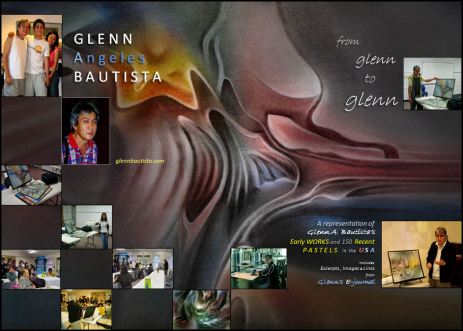
,
FOREWORD – by Alfredo R. Roces
.
As a young art student at the College of Fine Arts, University of the Philippines, Glenn Bautista introduced himself to the Philippine art public in extravagant and flamboyant fashion with two, massive, six feet by three feet, pen-and-ink on paper works. One was a drawing of Guillermo Tolentino’s celebrated UP statue “The Oblation” meticulous and carefully crafted in perfectly even parallel lines; the other a rendering of Rizal’s 39 poems including his celebrated Last Farewell that also limned the Rizal monument through a process of light and dark ink letters. A tour de force that marks Bautista’s hyperactive approach to art to this day. Glenn Bautista’s paintings straddle the world between the spiritual and the surreal. Carefully rendered with precise craftsmanship, his paintings, nevertheless, take on the appearance of free and spontaneous undulating forms that echo the rhythms of Nature. There is something of the German Bauhaus and the baroque in his images. The son of a Methodist minister, Glenn has tapped his religious background for his own aesthetic ends. His artistic journey has taken him from the Philippines to Germany and very recently to the United States. One can only wish such a diligent artist, God’s grace.
.
Alfredo R. Roces
.
Alfredo R. Roces (29 April 1923) is a painter and an essayist, a versatile artist. He won a grand prize for his painting Kundiman at the 25th AAP Annual Exhibition in 1972. He wrote many articles about art for various international magazines and daily column. He wrote and served as editor-in-chief of a ten-volume encyclopedia, Filipino Heritage. He also received four National Book Awards from the Manila Critics’ Circle (Legaspi, Ang Kiu Kok, Hidalgo, Adios Patria Adorada). He even branched out into pottery in Sydney, Australia..

.
Alfredo R. Roces
.
(29 April 1923)
.
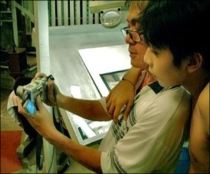
.
Dad Glenn sharing close-up insect photos with son, David
.
To my adored wife, Lorna and beloved son, David who continue to inspire me . . .
.
.
Copyright 2011 © Glenn A. Bautista
Technical Assistance: Doris B. Rifareal
Elizabeth B. Rifareal
(Designworkers.biz)
Text Edit: Eunice B. Laureano
↓
.
↓
*
↓
David, the ‘apple of our eyes’ went on to fascinate Lorna and me, even while he was yet a toddler. He wasn’t like a baby doing ‘baby talk’. He was almost right away talking, as if he was a teenager. Most likely, he got this from his very eloquent Mama Lorna. It couldn’t be from me for I have always been shy and timid, an introvert and one who loves solitude. Also, only if you had the chance to shake hands with David, his grip was amazingly strong and hands a bit rough. Even, at this early age, David already started appreciating things from nature.
.

.
Butterflyscape1 ’09
by Glenn A. Bautista
.
For one, daily, he would watch a caterpillar he found that we placed inside a screened bird cage together with the ‘ficus’ food plant including the twigs and leaves that it could feed on and hang on to. I cannot forget David’s surprised big eyes opened when the caterpillar came out from the cocoon as an amazing, colorful butterfly. It was a long-tail butterfly that David found. This experience had a great influence on David’s spirituality, which later on, he began to understand better as I had explained in this video, please click on the active title:
Uncle Glenn Remembering Tatay & Nanay
*
↓
An Art Review by John Altomonte- . The more I open up to the influence of each artwork, the deeper I go within myself…that is why I call the experience ‘spiritual’. I become aware that the harmonic vibrations that these art pieces emanate can actually change how I interact with the reality of the physical world outside my body. By observing this shift in consciousness I can also begin to understand how Glenn interacts with shapes found in nature. Knowing him as a deeply spiritual man, I can assume that these works are contemplative, at the same time essentially musical and therefore hymn like in presentation as consciousness drifts in and out of the framework in measured cadences. These are indeed, very beautifully inspiring work done by an artist who is expressing something which comes from a very special place within himself.” . – John Altomonte / Darwin, Australia March 2011
↓
.
.
.
↑
Two Letters from Glenn
. Dearest Family & Friends,
These “CyberArtPages” share with you a little bit about me, my early works and my recent soft pastels I have created while in Texas, California and Colorado since my arrival here in the United States last May 2009. It also includes links to images of people I have met and includes short narratives I have written about the places I have visited as I searched for inspiration to create my artworks. Art and life go together. They are inseparable. It is much like asking which one came first – – the chicken or the egg. As you go through this book you will really begin to understand why. ART is a vehicle in and through which we can look at things that touch our hearts and open our minds to fully comprehend what life around us is all about. The Lord’s infinite and constant goodness has inspired me to write this book, coupled with the inspiration from my adored wife Lorna and our beloved son David. Since I stepped on US soil in May 2009, Lorna and I felt so much closer to God despite our physical separation from our son David. We will always be thankful to Him for His unceasing and faithful protection, provision, guidance, wisdom and understanding of our circumstances during this time of our life. I earnestly encourage you to share this book with your family and friends. Only artwork that is devotedly created and sincerely appreciated has truly completed its full cycle. The creative expression of one’s thoughts and emotions through art brings about the sublime things of life, uplifting and inspiring us from the things that pull us down, helping us to understand the things around us, both seen and unseen, things that do matter in life that seem to escape us while we try to survive on this our planet Earth. Do not hesitate to connect with me online for any inquiries about learning more about my art or even learning how to draw or paint. I will be most happy to provide you guidance and direction.
God bless.
– glenn.angeles.bautista
.
Dearest Family & Friends, I treasure the privilege and the blessing of my physical existence on this part of the universe called Mother Earth – to have the rare opportunity to feel, sense, touch and taste what this physical life can offer. Yet, these physical sensations are nothing to compare with the majestic splendor of what our loving Creator has prepared for us. I thank God with all my heart for the total life experiences I have been blessed with and for the assurance of an everlasting life with Christ Jesus, my Lord and Savior. I am resting on His great promise when He said, “In my Father’s house are many mansions. If it were not so, I would not have told you”.
(John 14:2)
– glenn.angeles.bautista
↓
.
.
GLENN A. BAUTISTA was born on March 20, 1947 in Orion, Bataan, a province in Central Luzon, Philippines made infamous by the 1942 Bataan Death March. Glenn is the seventh of nine children in the family, all reared in the faith tradition of the United Methodist Church. His mother Eugenia Angeles was a deaconess, and his father, the Rev. Ignacio P. Bautista, was church minister for 39 years.

.
Glenn Bautista as
a pupil of Santa
Elementary School
in Manila, standing
tall at 4’3” behind
a height chart.
Glenn completed his education in Manila: his elementary education at the Sta. Ana Elementary School (1959); secondary education at the Union High School of Manila (1963); and college at the University of Santo Thomas (UST), the oldest existing university in Asia, and at the University of the Philippines (UP), the country’s national university and premier institution of higher learning. In 1969, he completed a certificate course in Advertising at the UP College of Fine Arts where he was a consistent university scholar. In 1971, Glenn received his Bachelor of Fine Arts degree at Brooks Institute in Santa Barbara, California, USA. He then went to Germany in 1982 to pursue further studies in lithography at the Staatliche Kunstakademie Düsseldorf. Glenn now resides in Houston, Texas, USA with his wife Lorna, a physiotherapist and food expert. Their son and only child David, drummer/percussionist of the band Southwind, is in the Philippines completing his undergraduate studies.
*
↓
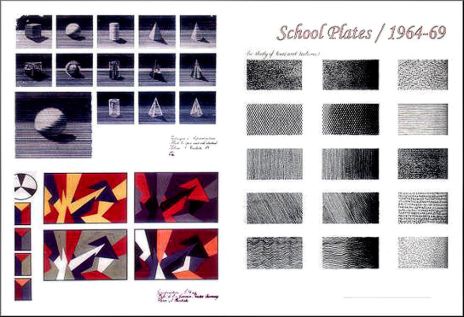
.
Glenn’s UST / UP Schoolplates
.
1964-69 – Image of a school plate from Prof. Rebilion’s Technique & Reproduction class
UP College of Fine Arts, Gonzales Hall
.
Body of work
Glenn’s art has been variously described as impressionistic, surreal, or futuristic. But as much as his art defies neat categorization, the artist himself evidently eccentric, Glenn Bautista is without doubt a master of the visual arts, proof of which is his extensive body of work. He has done paintings in oil and pastel, sketches on hand-made cogon-abaca paper, watercolours, collages, airbrush murals, street rubbings, bas-reliefs, cut-outs and sculptures, lithographs using the litho-press that he himself constructed, photography and videography, digital art, and even interactive net art. Glenn also successfully completed a personal architectural project, Glenn’Studio, which not only demonstrates his versatility and multidimensionality as an artist but also erected an enduring embodiment of his views and values on art and life. Located in Imus, Cavite, Philippines, Glenn’Studio houses the artist’s 300 Personal Artwork Collection, which includes pieces dating back to 1963 as well as current works. For over four decades, Glenn has created art with hardly a pause. His oeuvre to date features the following major works and themes:
- Religious paintings in oil
- Bocobo Mural (on permanent display at the UP Law Center; printed as Philippine postage stamp)
- Rizal Monument / pen-and-ink (1966-67)
- Gen. Emilio Aguinaldo Centennial Mural (1969)
- Sketches Series (1965-82)
- Portraits (1967-80)
- Inner-Light Series (1975)
- Prudential Bank, Makati branch / Mural (1975)
- In Search of the Divine (1976)
- Lithographs and Etchings (1976-85)
- Nude Pastels (1970-79)
- Art Photos (1980-82)
- Pencil Pastel Drawings (1981-91)
- Cogon-Abaca Drawings (1981-82)
- Zenscapes (1980-81)
- Cut-Outs (1980-85)
- Collages-Rubbings (1980-02)
- Soft Pastel Compositions (1981-87)
- Pilipinas / Philippine Consulate, Düsseldorf, Germany (1983)
- Creation Photo Series (1982-88)
- Bas-Reliefs (1984)
- Nature & Technology / Cosmic-Futuristic Compositions (1981-91)
- Watercolors (1982-88)
- Sculptures (1980-90)
- Cut / Torn / Folded works in paper (1989)
- New Earth Series (1985-91)
- Golfscapes / Manila Southwoods Golf & Country Club (1994-97)
- Abstractions in Oil (1993-98)
- Christian Art (1965-95)
- Digital Art Series (2002-2003)
- Figurescapes (2003)
- (Biblecomps (2004)
- Heaven & Earth Series / Large-format Oils (2005-08)
- Pastels in Texas, USA
.
Glenn’s Journey as an Artist
*
Glenn’s art is fundamentally grounded on the principles of the Christian faith, due in great measure to his being raised in, as he would say, “my old folks’ religion”. Much of his work is permeated with religious symbolism reflective of a deep personal piety. His early paintings dwelt on commonplace objects infused with Christian symbols and images. But while he started as a painter of portraits and religious subjects in the mid-1960s, Glenn through the years has produced works that explore diverse themes, forms and media. They bear marks of his sojourns, either to remote places in the Philippines or farther westward to the US, Spain, Germany or other parts of Europe, or inward to his inner light.
*
A watershed ‘event’ –  The Event (tempera on board), 1965. First Prize, International Christmas Art Competition, 1964/1965 World’s Fair, New York, N.Y., U.S.A. (©WLCL – World Literacy and Christian Literature, NCC 475 Riverside Drive, New York, N.Y. 10027. Printed in the U.S.A.) The turning point in his journey as an artist came in 1964 when, at the young age of 17 and encouraged by his father, Glenn participated in the International Christmas Art Competition sponsored by the New York-based World Literacy and Christian Literature organization. Submitted artworks were to be exhibited at the 1964/1965 World’s Fair in New York. Out of 64 entries from all over the world, Glenn’s The Event was declared winner. Soon afterward he received his check for the prize money and boxes of printed Christmas cards all bearing his artwork. Glenn never looked back since then. He knew painting would be his vocation, and he pursued it with a passion and dedication characteristic only of an artist destined to be a master. The Event served as the seminal work of Glenn’s art. In his biography, art critic Alice Guillermo writes: “Although Glenn Bautista later turned to other subjects and themes, there always lingered a trace of the religious in his paintings, either visually, as a solitary Christ figure in unfamiliar landscapes, or as a mood in mystical or supernatural atmosphere.”
The Event (tempera on board), 1965. First Prize, International Christmas Art Competition, 1964/1965 World’s Fair, New York, N.Y., U.S.A. (©WLCL – World Literacy and Christian Literature, NCC 475 Riverside Drive, New York, N.Y. 10027. Printed in the U.S.A.) The turning point in his journey as an artist came in 1964 when, at the young age of 17 and encouraged by his father, Glenn participated in the International Christmas Art Competition sponsored by the New York-based World Literacy and Christian Literature organization. Submitted artworks were to be exhibited at the 1964/1965 World’s Fair in New York. Out of 64 entries from all over the world, Glenn’s The Event was declared winner. Soon afterward he received his check for the prize money and boxes of printed Christmas cards all bearing his artwork. Glenn never looked back since then. He knew painting would be his vocation, and he pursued it with a passion and dedication characteristic only of an artist destined to be a master. The Event served as the seminal work of Glenn’s art. In his biography, art critic Alice Guillermo writes: “Although Glenn Bautista later turned to other subjects and themes, there always lingered a trace of the religious in his paintings, either visually, as a solitary Christ figure in unfamiliar landscapes, or as a mood in mystical or supernatural atmosphere.”
*
Painting History
.
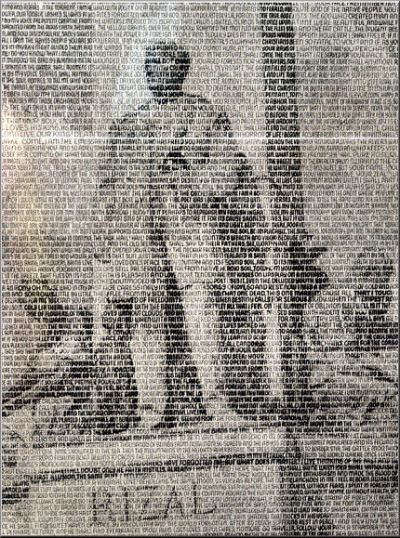
.
Many of Glenn’s early artworks dealt with historical subjects, some of which developed from his school plates in UST and UP, produced between 1963 and 1965. One of them is The Complete Poems of Dr. Jose Rizal Monument (1966), a pen-and-ink drawing composed of the complete 39 poems of the Philippine national hero, Dr. Jose Rizal, and one song, “A Orillas del Pasig”, which was translated into English by Glenn’s late friend, Alfredo Veloso. Rizal Monument was on exhibit for about six years at the Jose Rizal Shrine at Fort Santiago in Manila at the behest of the former First Lady of the Philippines, Imelda Romualdez Marcos.
.
.
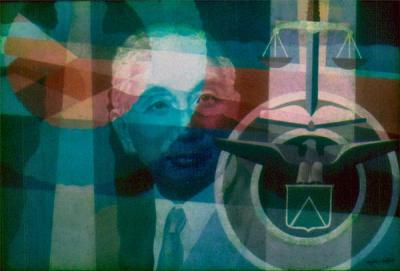
.
Justice Jorge Bocobo Mural by Artist Glenn A. Bautista, UP College of Law, UP Diliman, QC, Philippines (on permanent display at the UP Law Center; printed as Philippine postage stamp)
.
First solo exhibit
Following years of painting religious and historical subjects and a string of group exhibitions, Glenn finally had a chance to mount his first one-man show at the Ateneo Art Gallery in Quezon City, courtesy of curator Emmanuel Torres. Entitled Inscapes, the exhibition was held in August 1969 after his graduation from the UP College of Fine Arts. Dealing with commonplace subjects, Inscapes marked a new stage of development in Glenn’s art, paving the way for one of his more important works, the Inner Light Series.
.
Crusade scholarship
A year later, in 1970, Glenn went to the United States as a Crusade Scholar of the United Methodist Church. There he continued his art studies at the Brooks Institute School of Fine Art in Santa Barbara, California.
After two years of study, and upon the invitation of curator Ronald Kuchta, Glenn joined John Cushing and Stephen Samerjan for a Group Art Exhibition at the Santa Barbara Museum of Art. Their show coincided with the retrospective exhibition of Impressionist master Childe Hassam. Glenn’s works, which received critical praise, consisted of abstractions in diptychs and triptychs done with the airbrush, one of which, entitled Diptych, is now part of the museum’s art collection. His participation at the group exhibit earned him a Bachelor of Fine Arts degree (major in Painting) with honors. .

.
James Jarvaise / Glenn’s Art Teacher at the Santa Barbara Art Institute
(Brooks Institute) 1970-72 / Santa Barbara, California, USA: http://www.jarvaise.com/Biography.htm.
Professor “James” Jarvaise was not there in our class to teach us techniques in painting, although, he suggested a few then. But his focus was more philosophical than visual. He wanted us to go inwards in search of our inner-self, rather meditatively. Only then, he said, could we fully express ourselves in the medium of our choice, automatically, almost like a self-emptying process that cannot easily be stopped. Truly, this happened to me for I produced enough of my Woodscape series to exhibit at the Santa Barbara Museum of Art (SMBA). At Brooks, I am grateful to my professors Ron Robertson, Joseph Young, Advisers James Knowles and James Armstrong and the family I stayed with, the Radfords – – composed of wife and husband Marilyn-Anthony, two sons Peter and David, and daughter, Lynn. Santa Barbara is one place I will not mind settling down in to live permanently. Truly, it was a beautiful three year stay I had in Santa Barbara. Thanks to the UMC Crusade Scholarships for making this scholarship study possible.
It was a well-liked piece I did so I decided to include it for the school’s annual show at the end of the year. Because of this piece, I was inspired to do a series of works related to this icon which I entitled, Woodscapes. After two years at school, I was able to join a group show of artists from Santa Barbara – – John Cushing and Stephen Samejan where our works were exhibited at the Santa Barbara Museum of Art (SBMA). Then Art Curator, RONALD KUCHTA, made this significant group exhibition of three young artists from Santa Barbara, possible. This group exhibition coincided with the Impressionist Master Childe Hassam’s Retrospective show at the Santa Barbara Art Museum (SBMA). None of this would have been possible without the United Methodist Church Crusade Scholarship program.
.
↓
“Laskey Mural”
.

.
Subsequently, he held shows in New York at the Philippine Consulate and at Scarritt College in Nashville, Tennessee. In Nashville, he was commissioned to do the “Laskey Mural” in honor of Scaritt College founder, Virginia Davis Laskey. The Crusade Scholarship of the United Methodist Church in New York also commissioned him to do a mural entitled America.
.
.
“Abstractions” (1970)
.

.
Glenn held shows in Manila upon his return in 1971. His exhibit at Rustan’s Galerie Bleue, whose guest of honor was former First Lady Imelda Romualdez Marcos, featured “Abstractions” (1970), a wall-size painting executed with the airbrush.
.
.
Glenn A. Bautista / Recipient of the Thirteen Artists Award
.

.
In 1974, Glenn was one of the recipients of the Thirteen Artists Award, a triennial recognition given to emerging artists by the Cultural Center of the Philippines (CCP)
.
His 1975 show at the Lor Calma Gallery in Makati marked the beginning of his Inner Light Series, which consisted of 40 artworks in oil, each on a square format of 50.8 cm x 50.8 cm canvas. The Inner Light Series, an extension of his first show dealing with commonplace subjects, explored images of wood, tree trunks, and tree rings. Included in the series was one big piece entitled Woodscape which won the Critics’ Choice, an annual selection sponsored by the Ma-Yi Gallery under Susan Calo-Medina.
.
.
“In Search of the Divine” ( 1976)
.

.
In 1976, he exhibited yet another series entitled, In Search of the Divine at the Sining Kamalig. The presentation was highlighted by a night of music with the Madrigal Singers and poetry readings by Virgie Moreno, Larry Francia, Bobby Cuenca, Betsy Romualdez and Henry Francia.
.
.
Mastering Lithography
.
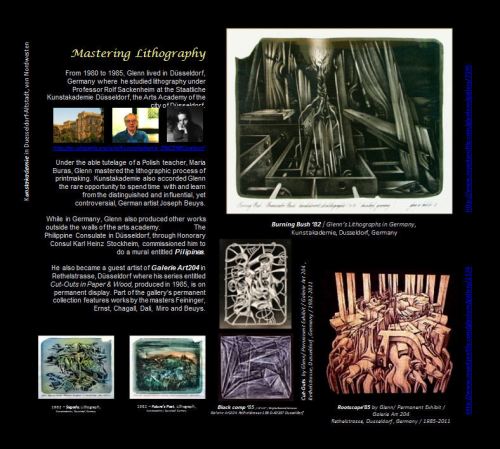
.
Mastering Lithography
.
From 1980 to 1985, Glenn lived in Düsseldorf, Germany where he studied lithography under Professor Rolf Sackenheim at the Staatliche Kunstakademie Düsseldorf, the Arts Academy of the city of Düsseldorf. Under the able tutelage of a Polish teacher, Maria Buras, Glenn mastered the lithographic process of printmaking. Kunstakademie also accorded Glenn the rare opportunity to spend time with and learn from the distinguished and influential, yet controversial, German artist Joseph Beuys.
While in Germany, Glenn also produced other works outside the walls of the arts academy. The Philippine Consulate in Düsseldorf, through Honorary Consul Karl Heinz Stockheim, commissioned him to do a mural entitled Pilipinas. He also became a guest artist of Galerie Art204 in Rethelstrasse, Düsseldorf where his series entitled Cut-Outs in Paper & Wood, produced in 1985, is on permanent display. Part of the gallery’s permanent collection features works by the masters Feininger, Ernst, Chagall, Dali, Miro and Beuys.
Alice G. Guillermo, The Uncommon Art of Glenn Bautista (Quezon City: E. L. Salas, 1997) ISBN 9719179503, p20
.
.
Glenn’s art in the eyes of…
.
.
Carlos P. Romulo, WORLD STATESMAN AND AUTHOR “… I looked admiringly at your 41 paintings one by one, and I can see how, while you do not wholly dispense with the object, you reconstitute it in accordance with a rhythm that you yourself determine and not derived from the object. In your aesthetic you do not concern yourself with creating fully realized forms for the sake of either ontological significance or realistic modeling; instead you successfully created structures composed of smaller elements, the planes, which in their juxtaposition, superimposition, or mingling produce a complex and pervasive rhythm which could not but win my admiration. … I believe you are destined to be one of our greatest in painting.” – March 22, 1971
.
Alice G. Guillermo, ART CRITIC “Total and spontaneous creativity is the principle that moves Glenn Bautista, wide-ranging artist who resist tested formulas and whose prodigious work in diverse media, two-and-three-dimensional, builds a universe of striking, haunting images that continually tease and challenge the mind. If landscapes, his paintings do not have the placidity and finality of familiar land-and-sky vistas but have the uncommon quality of concealing and revealing at the same time. If abstracts, his work, never facile, poses riddles and enigmas that resist categorical answers. If three-dimensional works, they defy conventional expectations in order to extend the meaning and experience of sculpture. …In time, it became clear that the art of Glenn Bautista is not one for the academically conservative and tradition-bound. Rather, it extends an invitation to the adventurous, being avant-garde in a quite inconspicuous way.” – 1997
.
Richard Ames, SANTA BARBARA NEWS PRESS (CALIFORNIA, USA) “Most of Glenn’s images seem to take place in a gigantic basement, a science-fiction subterranean world where lumber and metal pipes glow with a pulsating inner light. Here are remnants of today’s world seen with surreal imagination. It is pretty, pink, yellow, red and green pastel-colored vision of glowing growing crystals. Faucets, gigantic pencils, wood, cement blocks, metals and rocks are transformed into phantasies of purity, clarity and wonder.” – March 26, 1972
.
.
.
Paul B. Zafaralla, ART CRITIC “Originality is fast becoming synonymous with the name of Glenn A. Glenn. The first time he gained public notice, it was with his large murals about history at the University of the Philippines…. Since his graduation, he has been continually treating the art public with highly provocative artworks—aesthetically and intellectually—making it known to all that the human mind, particularly his, is capable of infinite creativity, even to the point of rendering art theories inutile. And gifted as he is with a deft hand, he has established an identity all his own, making himself as one of the few significant artists of the decade.” – December 26, 1976
.
Justin “Tiny” Nuyda, ARTIST-FRIEND “Difficult to understand and impossible to contain, the rapture, anguish and character genius of Glenn Bautista flow from oil painting, pastel and pencil drawing, photography, architectural design, lithography and to theoretical experimentations. He purposely leaves much to the imagination, which often enters the domain of mental bewilderment. His evocation of this very special terrain is so strong that art critics unanimously say Glenn Bautista is always eccentric.” – 1997
.
.
.
Internationally distinguished statesman Carlos P. Romulo, then the Philippines’ foreign affairs secretary, wrote to Glenn Bautista on 22 March 1971 following his one-man exhibition, “Glenn’s Works in Transparencies”, at the Savoy-Hyatt Hotel in Manila, which the Secretary ribbon-cut. He mailed the letter to the University of the Philippines College of Fine Arts where Glenn completed a course in advertising. Alice G. Guillermo, The Uncommon Art of Glenn Bautista (Quezon City: E. L. Salas, 1997) ISBN 9719179503, p6,10
.
Awards and recognition:
- 1965-67 – University Scholar, Arts and Sciences, University of the Philippines
- 1965-67 – Art Scholar, Children’s Museum and Library Inc., University of the Philippines
- 1965-67 – College Scholar, College of Fine Arts, University of the Philippines
- 1970-72 – Scholar, Honors, Brooks Institute of Fine Arts, Santa Barbara, California, Crusade Scholarships of the United Methodist Church, New York, U.S.A.
- 1964 December – First Prize, “The Event” (tempera), International Christmas Art Competition, New York City, sponsored by the World Literacy and Christian Literature, 475 Riverside Drive, New York, NY, U.S.A.
- 1967 October – Honorable Mention, “Chinese Garden” (oil), National Student’s Art Competition, sponsored by the Shell Company of the Philippines
- 1967 December – First Prize, “The U.P. Entrance” (oil), First U.P. On-the-Spot Painting Contest, U.P. President’s Committee on Culture
- 1968 March – Third Prize, “Main Building” (oil), 357th Anniversary Foundation Day On-the-spot Painting Contest, University of Santo Tomas
- 1968 October – First Prize, “Fort Santiago” (oil), sponsored by the Shell Company of the Philippines, National Student’s Art Competition
- 1968 December – Second Prize, “Arts and Sciences Building” (oil), Second U.P. On-the-Spot Painting Contest, sponsored by the President’s Committee on Culture
- 1969 March – First Prize, “Aguinaldo Portrait Mural” (oil), 11’ft x 17’ft, sponsored by the Aguinaldo Centennial Commission
- 1972 May – Award of Merit, “My First Week at Brooks”, Student’s Art Competition, Brooks Institute of Fine Arts, Santa Barbara, California, U.S.A.
- 1982-1985 – Guest Student, Lithography, under Professors Rolf Sackenheim and Maria Buras, Kunstakademie, Düsseldorf, Northrein Wesphalia, Germany
- 2005 March – Nominee, National Artist of the Philippines, National Council of the Arts, Cultural Center of the Philippines
- 2007-2008 – President Nominee, Chairman-International Service Group / Rotary Club of Parañaque Sucat (RCPS) District 3830
- 2009 September – Weatherford Art Association, Member
- 1964 – “Imelda Portrait”, sponsored by the Childrens’ Museum & Library, Inc., Malacanang Palace, Philippines/
- 1966 – “Rizal & Oblation”, (pen & ink), Gonzales Hall, Diliman, Quezon City, Philippines
Exhibitions:
- 1967 – “Glenn’s Early Religious Works”, Abelardo Hall, University of the Philippines, Diliman, Quezon City, Philippines
- 1967 – “My Yoke is Easy”, Dasmariñas, Cavite, Philippines
- 1967 – “ Christian Art”, Saint Andrew’s Seminary, Manila, Philippines
- 1968 – “Come All Ye”, Union Church of Manila, Makati, Philippines
- 1968 March – “CMLI Art Scholars Art Exhibition”, Philamlife Building, United Nations Ave., Manila, Philippines
- 1969 August – “Inscapes”, Ateneo Art Gallery, Quezon City, Philippines
- 1971 March – “Glenn’s Works in Transparencies” (ribbon-cut by Carlos P. Romulo), Arts & Ends Gallery, Savoy-Hyatt Hotel, Manila, Philippines
- 1971 – “On My Way to School”, Brooks Institute of Fine Arts Gallery, Santa Barbara, California, U.S.A.
- 1972 March – “Three-Man Show”, with Artists John Cushing & Stephen Samerjan / Santa Barbara Museum of Art, California, U.S.A.,
- 1972 June – “America”, Inter-Church Center, Riverside Drive, New York, N.Y., U.S.A.
- 1972 July – “Pilipinas”, “Glenn’s Solo Art Exhibition”, Philippine Consulate, NY, USA
- 1972 June – “Two-Man Show” with Danny Aguila, Scarrit College, Laskey Gallery, Nashville, Tennessee, U.S.A. 1973 March – “Filipino Artists’“ Group Show, Sining Kamalig, Manila, Philippines
- 1973 December – “Zen Series”, Galerie Bleue, Makati, Philippines
- 1974 -“Thirteen Artists ‘74” – “Thirteen Artists“, Cultural Center of the Philippines, Manila, Philippines
- 1975 August – “Inner-Light Series”, Metro Gallery, Lor Calma Building, Makati, Philippines
- 1976 December – “In Search of the Divine”, Sining Kamalig, Manila, Philippines
- 1976 – “U.P. Artists’ Group Show”, University of the Philippines, Manila, Philippines
- 1977 – “Rizal”, (pen & ink) Fort Santiago, Philippines/
- 1977 October – “Branches”, Art Associates Gallery, Makati, Philippines
- 1977 – “Seasons & Generations”, Group Show, Cultural Center of the Philippines
- 1978 March – “Balik-Gallery”, Art Associates Gallery, Makati, Philippines
- 1978 August – “Sambahan”, Photography Group Show, Sining Kamalig, Manila, Philippines
- 1978 December – “Religious Paintings”, Residence of the U.S. Ambassador to the Philippines
- 1978 December – “Christmas Group Show”, Luz Gallery, Makati, Philippines
- 1978 March – “Nudescapes”, Ma-yi Associates, Makati, Philippines
- 1978 October – “Paintings & Sketches”, Sining Kamalig, Regent of Manila1979 November – Critics’ Choice – “Woodscape”, Manila Mandarin Hotel, jointly sponsored by the
- Philippine Commercial & Industrial Bank and Ma-yi Associates 1980 October – “Philippine
- Paintings” – Old & New, Madurodam Complex, Hague, under the auspices of the Philippine Embassy and Philippine Airlines
- 1981 November – “Group Show”, Dr. Fores Residence, New Manila, Quezon City
- 1982 March – “Abstractions”, ABC Galleries, Manila, Philippines
- 1983 August – “Tribute to Drawings” (Group Show), Gallery Genesis, Metro Manila, Philippines
- 1984 October – “First Group Show”, Parañaque, Las Piñas Art Exhibition, Tropical Palace, Metro-Manila, Philippines
- 1985 February – “1985 ASEAN Show”, National Museum of Singapore
- 1985 – “Preview of Munich Show”, sponsored by the Museum of Philippine Art
- 1985 –”International Artists, Art Exhibition”, Sharjah Museum of Art, Sharjah
- 1985 March – “Cut-Outs in Paper & Wood” (permanent exhibit as guest artist- , c/o Brigitte & Manfred Schmidt/), Galerie Art 204, Rethelstrasse, Düsseldorf, Germany Parker Williams Art Talk/Exhibit
- 1985 September – “Nature & Technology”, Gallery Genesis, Mandaluyong, Metro Manila
- 1987 – “Halo-Halo”, Little Gallery, CCP, Manila
- 1988 – Fifth “Kulay sa Tubig” Competition/Exhibition, Gallery Genesis, Mandaluyong, Metro Manila
- 1990 – Seventh “Kulay sa Tubig” Competition/Exhibition, Gallery Genesis, Mandaluyong, Metro Manila
- 1990 – “Golfscape Series”, SouthWoods Golf & Country Club/
- 1994 – “Landscapes & Abstractions”, Capitol Bank, Philippines/2009 October to
- 2010 March – Participated in Group Art Exhibits / Member, The Weatherford Art Association, Firehouse Gallery & Art Center, 119 West Palo Pinto St., Weatherford, Texas 76086, (817) 599-3278, Email: weatherfordart@yahoo.com
- 2010 March 27 – Parker Williams Art Talk/Exhibit, Parker Williams Library, 10851 Scarsdale Boulevard, Suite #510. Houston, TX
- 2010 April 2 –Southpoint Art Talk/Exhibit, 12801 Roydon Dr., Houston, TX 77034 USA
- 2010 April 3 – Houston Trinity UMC Art Talk/Exhibit, Houston, TX Speaker, Easter Sunrise Service, South Barker Cypress Rd., Katy, Texas 77450
.
*
↑
*
Future’s Past – Vergangenheit der Zukunft
by Alice Guerrero Guillermo . Undoubtedly one of the most gifted artists of his generation, Glenn Bautista believes in total creativity. Wide-ranging in his production, he has distinguished himself in painting, whether in oil, pastel, or watercolor, in printmaking, particularly lithography, and in sculpture, freestanding or relief. He knew his artistic vocation from an early age — he was born in 1947 in Orion, Bataan — and he has since pursued his career with a single-mindedness of purpose. [Sketches] Thus, he graduated with a degree of Fine Arts from the University of the Philippines in 1969, and on a scholarship grant, took further studies at Brooks Institute in Santa Barbara, California where he graduated with honors in 1971. He has recently come back from Germany where he specialized in lithography at the ‘Kunstakademie’ in Dusseldorf and experimented with new materials and processes. Bautista’s recent shows cover his artistic production for the last three years, with most of the works done in Germany. It is significant here to note that during the time he was there, he won an ample measure of critical recognition as his works have become part of the permanent exhibit at the Galerie Art 204 at Rethelstrasse, Dusseldorf, in the company of the works of Josef Beuys, and the masters Chagall, Dali, and Miro. His one-man show at the Gallery Genesis this September attests to his prolific expression and consistent excellence and includes works in various media: paintings in pastel, mixed media works, collages, and works on handmade paper, photographs, lithographs, and cement sculpture. [Christian Art] Glenn Bautista started in the mid-Sixties as a painter of religious subjects and portraits. From the start, however, his art bore the stamp of his spontaneous originality which is the constant characteristic of his work. His early paintings of religious subjects done in the idiom of transparent cubism, more curvilinear than geometric, and which had a luminous stained-glass effect, endowed the traditional subjects with a new freshness and spiritual insight, While these early works were orthodox Christian, the religious aspect of his art acquired an increasingly eclectic character, drawing in elements and concepts from Asian religions to create a spiritual synthesis and unity of religious worship. [Inner-Light] In the Seventies, the imagery of his art moved from the religious to the surreal, as in his Inner Light Series, 1975 in oil on canvas, with titles such as Buried Time, Aquascape, Firefly, Transience, and Woodscape. It is, however, important to note that the surrealism of Glenn Bautista draws its original principle from his religious works. The sacred aura and luminous presence of his earlier works became gradually shifted to another context, this time the surrealist vision. [Pastels] How are we to define the specific character and quality of Glenn Bautista’s surrealist vision by which it distinguishes itself from the work of other surrealists? In terms of quality and feeling, it is, as we have earlier mentioned, drawn from his early religious consciousness. Thus, whether the subject be interplanetary outposts in a desert space, or trees and organic growths, it bears a spiritual presence beyond the original religious source. This abstractized religious quality is conveyed through the style itself, and, to a large extent, by the pastel medium as it is used by the artist in his individual style. In his hands, pastel assumes a rare suppleness, which, however does not preclude the clear and precise articulation of detail, the aura, spiritual or magical, is the effect of his exquisite control of light and tone. It is indeed surprising what a large tonal range can be accommodated within a small format of twelve and one fourth inches square. Often, light shines from within the forms like mysterious and beckoning Grail. It may flood valleys and gorges in a soft radiance that contrasts with the raggedness of the cliffs rising around. Light falls, like cascades, like torrents, like silent water down the slopes or the steep inclines of unknown mountains. With the light, color modulates from the purple to rose to orange with shades of gray, as the hues are brought out in all their original vividness and in their entire range of expression. Because of the intense concentration of imagery in a small format, along with the artist’s mastery of his technical means, and the flexibility and suppleness of his handling, many of the works achieve the macrocosmic dimension in their visionary scale. A small work — significantly, a square field with its equal sides — contains features on microcosm, which, in their rich and intricate interrelationships, project infinitely into a vast macrocosm, the multiple universe of endless space. The tonalities of light and dark when put into service of the linear perspective of surrealism create a trajectory into infinity, above and beyond the painting’s visual field, particularly since the artist does not mark a horizon line but telescopes, structures and crops the boundless image within the confines of the ordering square. [Abstractions] In fact, in a number of his works, Bautista has modified traditional perspective of linear convergence into more complex formulations. In some striking works, the schema of perspectival lines is elaborated into a contrapuntal network of lines that touch at points, separate and recede in an irregular zigzagging movement. The pool or subterranean depth from which a light wells out and radiates from a series of concentric layers and softly articulates the environing shapes. Another kind of perspective is off-centered and asymmetrical, as in semi-circular low-lying valley or river basin that interplays with steeply rising cliffs or a flat desert. The point of view from high Olympian vantage points is omniscient, spanning an immense temporal and spatial distance. [Heaven&Earth Oils] Thus, in these images of mystical evocation, the primitive archetypal past and the interplanetary future converge, as they reveal (and the artist has identified this as a central theme) underlying similarity of structures. The winding and tortuous mountain trails of what seems like an abandoned sky-city of Andes, Machu Picchu, perhaps, find a contemporary echo in the elaborate system of gas pipelines in a highly industrialized region, the Ruhr in Central Europe, for instance. For one, however, the images of ancient cities and ghost trails in inaccessible mountain fortresses often include the element of the organic, in the allusion to strong and ancient roots that reach down into the depths of the earth. On the other hand, the images of pipelines and what they signify of advanced industrial technology convey, in their formidable metallic structure a latent protest against dehumanization of man and decentering of his unique personality by the mammoth of mechanization. The concept of an inexorable industrial ‘‘progress’’ and the toll to the human spirit that it exacts coalesce in the powerful image of the bird’s claw with its avid and cruelly pointed talons that seem to spread out from a hard center of unrelenting steel. [Folded-Cut-Torn Pastels] In all the pastel works, however the sophisticated sense of structure the interplay of past and present and of the organic and mechanical the atmospheric space, and the quality of light blazing like a flare or softly phosphorescent-like marine forms glowing in a subterranean seas, are constant themes, of which the primary is the pervasive aura of spiritual presence the mystical, now abstracted from original context of religious orthodoxy. [Art Photos] [Insects/Photos] The same imagery as in the pastel works occurs in the photographs which are instant constructions, usually of sand and found objects, combined with sculptural forms, photographed in site. Close-up photography lends the subject of shells, rocks, and leaves, chambered nautilus, and an occasional surprise, in a rearing head of Christ, the illusion of actual existence, because of the camera’s natural function of recording material reality. It is best to relate the pastels to the photographs and vice-versa, because such comparative viewing brings out keenly the way in which a subject undergoes a shift in meaning as it is transposed into a different artistic medium. In these works, the artist is intrigued with the variation of existence of a visual sign appearing in art. In fact, the same concerns and interests which may easily grow into obsessions, also find expression in the cement relief sculptures which give the subjects another, a third, dimension of existence, this time three-dimensional with solid mass and texture. [Bas-Reliefs] In both the pastel works and the cement reliefs, the format is square, thus pointing to a real interrelationship. The textured white fields of his reliefs correspond to the desert sands of the pastel works as well as to the fine beach sand in the photographs. It becomes clear that in Glenn Bautista’s works, sand is a medium, actual or illusory, which, like water, is an essential part of this surrealist vision which both conceals, submerges or blankets like snow at the same time that it reveals and exposes mysteries of the unconscious. [Collage-Drawing] The artist rises to the conscious level and reckons reality in all its color and movement in his big collages that take off from posters and in his smaller works of mixed media that combine collage, line drawings, pastel passages and rubbings. Done in Germany, these show the contemporary First World urban environment impinging on the artist’s consciousness from all directions. The imagery of these works conveys the sophistication of cine-clubs, theaters, and outdoor cafes the very structure of a well-ordered bourgeois urban milieu in the rubbings of fire hydrants, manhole covers, street signs with the immediacy of their textures, and in the vintage appeal of Chaplin posters in the context of European pop. [Cogon-Abaca Drawings] Not to be overlooked is a collection of small works on paper — particularly finely textured handmade paper from cogon and abacaproduced in Baguio studio-workshops. On these, the artist has painted with pencil and pastel European landscapes of a more familiar and reassuring scale and on-the-spot renderings of elements of the urban scene: houses, doors, windows, interiors, with particular interest in their framework and structural features. In these he has consciously brought out the textural particularities of the handmade paper to become elements of meaning in the image as a whole. At times, one senses the superimposing of two planes of existence, the European and the Philippine in the medium and the image, at other times, these two planes originating from different cultural contexts and sensibilities, remain separate and apart. [Garland Pastels] But there is always and increasingly more in the art of Glenn Bautista whose artistic creativity is multifaceted and multidirectional. His lithographs, for instance, can challenge the best in the international scene. His surrealist works are true individual reformulations of that probing vision. In his works, form and vision seem to vie with each other in their pursuit of new directions and discoveries in the vast unending field that is his artist’s terrain and which he explores in its dimensions of time and space and in its surface life and materiality as in the deep and subterranean movements and phenomena of man’s other self. About the Author: Studied at the College of the Holy Spirit and the Universite’d Aix-Marseille in France as a scholar of the French Government. She finished her Ph.D (Philippine Studies) at the University of the Philippines with the dissertation entitled “Protest/Revolutionary Art in the Marcos Regime”. She was the recipient of the Art Association of the Philippines Art Criticism Award in 1976. She also received the UP Chancellor’s Award on Best Research in 1996. In the same year she was a Research Fellow of the Japan Foundation in Tokyo. She is married to the poet Gelacio Guillermo and has two children, Sofia and Ramon. – The Uncommon Art of Glenn Bautista by Alice Guerrero Guillermo Excerpts: “Total and spontaneous creativity is the principle that moves Glenn Bautista, wide-ranging artist who resist tested formulas and whose prodigious work in diverse media, two-and-three-dimensional, builds a universe of striking, haunting images that continually tease and challenge the mind. If landscapes, his paintings do not have the placidity and finality of familiar land-and-sky vistas but have the uncommon quality of concealing and revealing at the same time. If abstracts, his work, never facile, pose riddles and enigmas that resist categorical answers. If three-dimensional works, they defy conventional expectations in order to extend the meaning and experience of sculpture.” “In time, it became clear that the “Uncommon Art of Glenn Bautista” is not one for the academically conservative and tradition-bound, rather it extends an invitation to the adventurous, being avant-garde in a quite unobtrusive way. Even more, it has made a lasting mark on figurative art in the country today as it has opened numerous options, at the same time that it has engaged in the lively, exciting and highly original synthesis. Bautista, at present, devotes much of his time giving free art lessons to children and adults in Parañaque City. Glenn was a nominee for the prestigious 2005 National Artist Award of the Philippines in the field of Visual Arts as a result of recommendations received from some civic and religious organizations where he has been involved with who are appreciative of his works and efforts.” About the Author: Studied at the College of the Holy Spirit and the Universite’d Aix-Marseille in France as a scholar of the French Government. She finished her Ph.D (Philippine Studies) at the University of the Philippines with the dissertation entitled “Protest/Revolutionary Art in the Marcos Regime”. She was the recipient of the Art Association of the Philippines Art Criticism Award in 1976. She also received the UP Chancellor’s Award on Best Research in 1996. In the same year she was a Research Fellow of the Japan Foundation in Tokyo. She is married to the poet Gelacio Guillermo and has two children, Sofia and Ramon.
.
↓
GLENN’S OTHER BLOGS
: https://glenlorndav.wordpress.com/2013/09/27/glenns-cyberartpages-1963-2013-on/
* * *
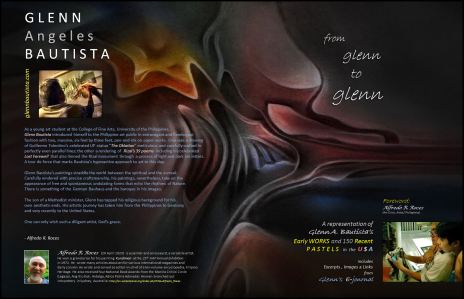



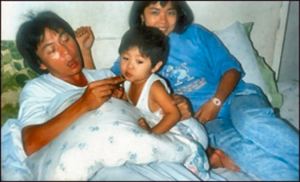
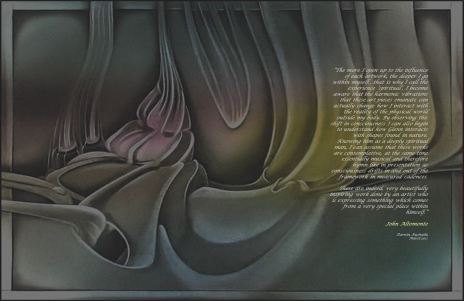








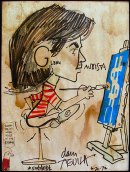


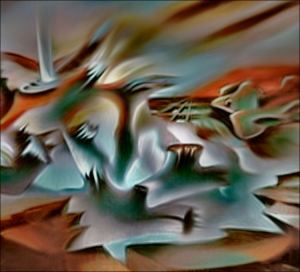
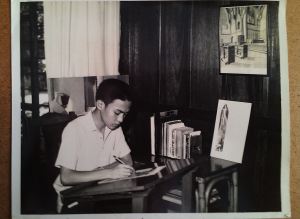
Reblogged this on Glenn's CyberArtPages.
Pingback: BF Gallery-Studio Renov / BautistaFam Reunion-Sept ’12 | Glenn's CyberArtPages